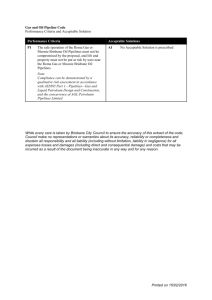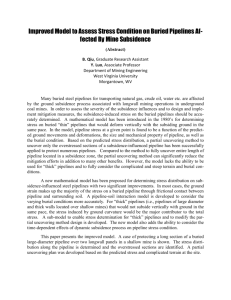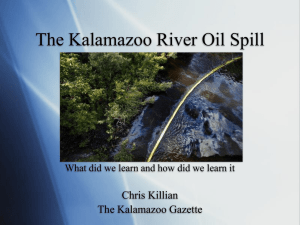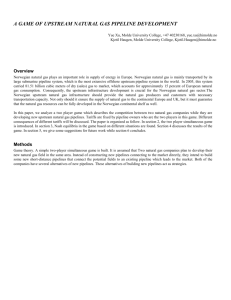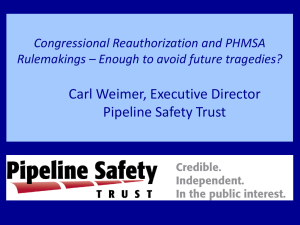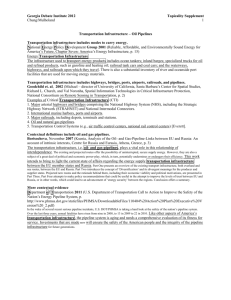XII. Impacts on Major Pipelines, Roads and Public Facilities
advertisement
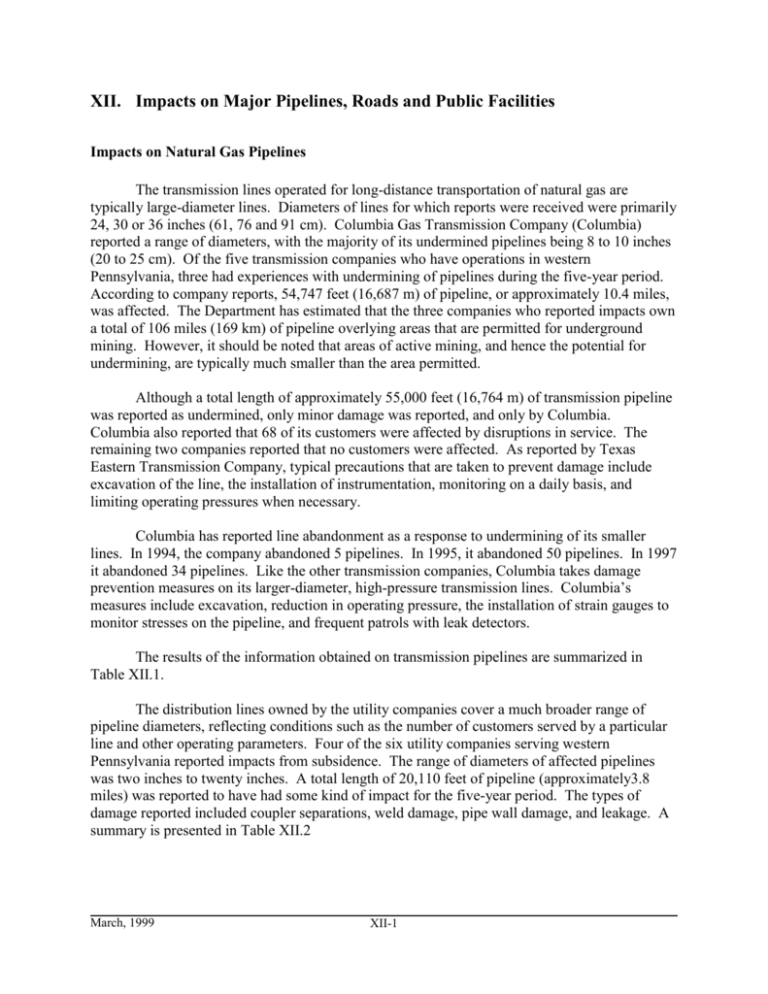
XII. Impacts on Major Pipelines, Roads and Public Facilities Impacts on Natural Gas Pipelines The transmission lines operated for long-distance transportation of natural gas are typically large-diameter lines. Diameters of lines for which reports were received were primarily 24, 30 or 36 inches (61, 76 and 91 cm). Columbia Gas Transmission Company (Columbia) reported a range of diameters, with the majority of its undermined pipelines being 8 to 10 inches (20 to 25 cm). Of the five transmission companies who have operations in western Pennsylvania, three had experiences with undermining of pipelines during the five-year period. According to company reports, 54,747 feet (16,687 m) of pipeline, or approximately 10.4 miles, was affected. The Department has estimated that the three companies who reported impacts own a total of 106 miles (169 km) of pipeline overlying areas that are permitted for underground mining. However, it should be noted that areas of active mining, and hence the potential for undermining, are typically much smaller than the area permitted. Although a total length of approximately 55,000 feet (16,764 m) of transmission pipeline was reported as undermined, only minor damage was reported, and only by Columbia. Columbia also reported that 68 of its customers were affected by disruptions in service. The remaining two companies reported that no customers were affected. As reported by Texas Eastern Transmission Company, typical precautions that are taken to prevent damage include excavation of the line, the installation of instrumentation, monitoring on a daily basis, and limiting operating pressures when necessary. Columbia has reported line abandonment as a response to undermining of its smaller lines. In 1994, the company abandoned 5 pipelines. In 1995, it abandoned 50 pipelines. In 1997 it abandoned 34 pipelines. Like the other transmission companies, Columbia takes damage prevention measures on its larger-diameter, high-pressure transmission lines. Columbia’s measures include excavation, reduction in operating pressure, the installation of strain gauges to monitor stresses on the pipeline, and frequent patrols with leak detectors. The results of the information obtained on transmission pipelines are summarized in Table XII.1. The distribution lines owned by the utility companies cover a much broader range of pipeline diameters, reflecting conditions such as the number of customers served by a particular line and other operating parameters. Four of the six utility companies serving western Pennsylvania reported impacts from subsidence. The range of diameters of affected pipelines was two inches to twenty inches. A total length of 20,110 feet of pipeline (approximately3.8 miles) was reported to have had some kind of impact for the five-year period. The types of damage reported included coupler separations, weld damage, pipe wall damage, and leakage. A summary is presented in Table XII.2 March, 1999 XII-1 XII. Impacts on Major Pipelines, Roads and Public Facilities Table XII.1 Summary of Impacts – Transmission Pipelines Company Columbia Gas Transmission Company Dates Undermined 12/94-9/98 CNG Transmission Corporation Tennessee Gas Pipeline Texas Eastern Transmission 9/93 – 5/94 Transcontinental Gas Pipeline Corporation None Types of pipelines One 1.5-inch One 4-inch Five 8-inch Eleven 8/10-inch One 20/24-inch Two 24-inch Total length 20,347 feet 2,200 feet Damage 15 feet of 10inch seven line separation incidents None None 1996 – 1998 Three 24-inch, four 30-inch and two 36-inch 32,300 feet None Table XII.2 Summary of Impacts – Local Distribution Pipelines Carnegie Natural Gas Company Columbia Gas of Pennsylvania Equitable Gas Company National Fuel Distribution Corporation Peoples Natural Gas Company T. W. Phillips Oil and Gas Company 02/15/16 Dates Undermined 3/97 – 10/98 Types of pipelines 4-inch, four 12inch, and 16-inch Total length Damage 4,000 feet Coupler separations 1994 – 1995 2-inch and 4-inch 3,500 feet Line separation 6/96 – 1/97 2-inch and 4-inch 910 feet Wall and weld damage 11,700 feet Leakage in one pipe None 1/94 – 10/98 12-inch, two 20inch None XII-2 Draft: Version 4 XII. Impacts on Major Pipelines, Roads and Public Facilities The incidents reported also resulted in service disruptions. However, these disruptions were related to the utility company making alternative arrangements for affected customers for the duration of the undermining. For example, one company temporarily converted forty customers to electric service. Another company reported that small numbers of customers had their service interrupted for brief periods of time. In total, only 55 natural gas customers were directly affected because of undermining of pipelines owned by utility companies during the five-year period. Most companies have established procedures for dealing with the undermining of their pipelines. Although the details may vary from company to company, the guidance followed by Equitable Gas Company is fairly typical. The company: Identifies affected pipelines Temporarily shuts off gas service to all customers affected by the mining activity Exposes pipelines (as necessary) to provide stress relief Conducts leakage surveys over affected main and service lines at scheduled intervals After completion of mining, pressure tests main, service or house lines, as required, to verify integrity of the system. Because of competitive considerations, Pennsylvania’s utility companies do not publish the lengths of pipelines that are a part of their systems. However, the natural gas local distribution system is much more extensive than the transmission system. Responses relating to the issue of responsibility for the costs of dealing with the impacts reported confirm the reality: the coal operator and the utility company typically resolve this issue in accordance with their respective property rights. One utility company reported being compensated for costs related to the undermining of one of its lines, consistent with a formal agreement between the two parties. Other utility companies noted that they had not been compensated for their costs of implementing precautionary measures, presumably because the coal company had superior property rights. In summary, a review of the questionnaire responses suggests that the undermining of utility pipelines did not create any hazards to human safety, nor did it compromise the ability of the affected companies to maintain acceptable service to their customers. It is recognized, however, that a small number of customers experienced temporary disruptions to their service. Impacts on Infrastructure of Public Service Providers In order to solicit information regarding subsidence-induced damage to the infrastructure of the study area, a survey was conducted of public service providers located above or adjacent to the permit areas of active underground mines. A total of 188 municipalities, PennDot engineering districts, water authorities, and sewerage authorities were mailed questionnaires. The Department received 77 responses to its survey. Several respondents reported mining related problems that are unrelated to active underground coal extraction, such as subsidence 02/15/16 XII-3 Draft: Version 4 XII. Impacts on Major Pipelines, Roads and Public Facilities damage from abandoned mines, erosion damage caused by abandoned mine discharges, and damage to roads due to coal truck traffic. For the purposes of this report, questionnaires documenting problems unrelated to underground coal extraction over the previous five-year period have been included under the “no problems reported” category. The following is a breakdown of 77 survey responses, followed by a description of the types of damage reported. Table XII.3 Summary of Responses Organization No. of Responses PennDot District engineering offices Local government bodies Municipal water/sewer authorities Total No Reported Problems* 4 3 39 31 34 33 77 67 Subsidence Damage to Roads State Township Damage to Water Supply and Sewerage Conveyance Systems 1 8 1 1 8 1 * Questionnaires were sent to public service providers based on their location relative to permit boundaries of underground operations. Some of the areas targeted by the survey were not located above active coal extraction areas. Description of Damage Damage to state roads – All of the reported incidents of damage to state roads occurred in either Washington or Greene counties. Seven separate incidents were reported. Three incidents involved the cracking and buckling of state roadways (a total of approximately three miles of road was affected). Two incidents resulted in landslides that temporarily closed two state roads. One incident caused a bridge and surrounding drainage network to be adversely affected by differential settlement, and another incident resulted in a major dip in a road that was deemed by PennDot to be a hazard to motorists. Damage to township roads – Approximately 5000 feet (1524 m) of township roads were reported to be damaged due to undermining. Damages included road surface cracking and buckling, dips due to settlement, and in one case a 30 inch “hump” in the road surface extending from berm to berm. Damage to water supply and sewerage systems – This category included one report of damage. The respondent indicated that nearby underground mining had caused reduced yield and water quality degradation at a municipal water supply well field. 02/15/16 XII-4 Draft: Version 4
